IJCRR - 4(1), January, 2012
Pages: 95-103
Print Article
Download XML Download PDF
Impact of Distillery Spentwash Irrigation on Sprouting and Growth of Himalayan Balsam (Balsaminaceae) and Crossandra (Acanthaceae) Flowering plants
Author: S. Chandraju, C. Thejovathi, C. S. Chidan Kumar
Category: General Sciences
Abstract:Germination of Himalayan Balsam (Balsaminaceae) and Crossandra (Acanthaceae) seeds was made by irrigated with distillery spentwash of different concentrations. The spentwash i.e., primary treated spentwash (PTSW), 1:1, 1:2, and 1:3 spent wash were analyzed for their plant nutrients such as nitrogen, phosphorous, potassium and other physical and chemical characteristics. Experimental soil was tested for its chemical and physical parameters. Himalayan Balsam and crossandra seeds were sowed in different pots and irrigated with raw water (RW), 1:1, 1:2 and 1:3 spentwash. The nature of germination of seeds was studied. It was found that, the germination was very good (100%) in 1:3 SW irrigation, while very poor (25%) in 1:1 SW, moderate (80%) in 1:2 SW and 95% in RW irrigations.
Keywords: Distillery spentwash, Himalayan Balsam , Crossandra , Germination, Growth, Irrigation, Soil.
Full Text:
INTRODUCTION
Himalayan Balsam belongs to the family Balsaminaceae. It typically grows to 1 to 2 m high, with a soft green or red-tinged stem, and lanceolate leaves 5 to 23 cm long. The crushed foliage has a strong musty smell. The flowers are pink, with a hooded shape, 3 to 4 cm broad the flower shape has been compared to a policeman?s helmet, giving rise to the alternative common name Policeman?s Helmet. Although it does not range all over India and is by no means the only Impatiens native to that country, it is also known as Indian Balsam in countries where it is introduced. In India it is commonly called as Karnakundala.
Himalayan Balsam, Impatiens glandulifera, is a large annual plant, native to the Himalayans (resulting in its colloquial name of Kiss-me-on-themountain1 in the UK. After flowering between June and October, the plant forms seed pods 2 to 3 cm long and 8mm broad. Which explode when disturbed, scattering the seeds up to 7 meters. The green seed pods and seeds can be eaten, and also the young leaves and shoots. Which is a method of controlling the plant?s spread2- 4 . However, a recent study it may cause more harm than good. Destroying riparian stands of Himalayan Balsam can open up the habitat for more aggressive invasive plants. The Bionic Control of Invasive Weeds in Wiesbaden, Germany is trying to establish a self sufficient project to conserve their local biodiversity by developing several food products made from the Impatiens flowers. Eventually, if all goes well, this project will have the Himalayan Balsam financing its own eradication.
Crossandra is belongs to the family Acanthaceae, comprising 52 species that occur in Africa, Madagascar, Arabia and the Indian subcontinent. Some species, especially Crossandra infundibuliformis5,6, are cultivated for their brightly colored flowers. It is known as Kanakambara in Karnataka, southern states in India. Crossandra from the Greek, meaning fringed anthers. The male portion of the flower, the anthers, is distinctly fringed in this genus of plants. The firecracker flower, while relatively unknown to the general public as a houseplant, is just about the most prolifilic indoor flowering plant. A well tended specimen will bloom continuously for years. It is growing from four sided stalked spikes; the asymmetrical petals arise as a slender tube and then split in to their ends. Plant breeders, especially in Europe, have been hybridizing Crossandras. Cultivars with yellow and even red flowers are available. Crossandra is a sturdy, productive ornamental that should be more popular with indoor gardens.
Molasses (one of the important byproducts of sugar industry) is the chief source for the production of ethanol in distilleries by fermentation method. About 08 (eight) liters of wastewater is generated for every liter of ethanol production in distilleries, known as raw spentwash (RSW), which is known for high biological oxygen demand (BOD: 5000- 8000mg/L) and chemical oxygen demand (COD: 25000-30000mg/L), undesirable color and foul odor7 . Discharge of RSW into open field or nearby water bodies results in environmental, water and soil pollution including threat to plant and animal lives. The RSW is highly acidic and contains easily oxidisable organic matter with very high BOD and COD 8 . Also, spentwash contains high organic nitrogen and nutrients 9 . By installing biomethenation plant in distilleries, reduces the oxygen demand of RSW, the resulting spentwash is called primary treated spentwash (PTSW) and primary treatment to RSW increases the nitrogen (N), potassium (K), and phosphorous (P) contents and decreases calcium (Ca), magnesium (Mg), sodium (Na), chloride (Cl- ), and sulphate (SO4 2- ) 10. PTSW is rich in potassium (K), sulphur (S), nitrogen (N), phosphorous (P) as well as easily biodegradable organic matter and its application to soil has been reported to increase yield of sugar cane, wheat and rice 11, Quality of groundnut 12 and physiological response of soybean13. Diluted spentwash could be used for irrigation purpose without adversely affecting soil fertility14 , seed germination and crop productivity 15. The diluted spent wash irrigation improved the physical and chemical properties of the soil and further increased soil micro flora16, 17, 18 . Twelve pre-sowing irrigations with the diluted spent wash had no adverse effect on the germination of maize but improved the growth19. Diluted spentwash increases the growth of shoot length, leaf number per plant, leaf area and chlorophyll content of peas20 . Increased concentration of spent wash causes decreased seed germination, seedling growth and chlorophyll content in Sunflowers (Helianthus annuus) and the spentwash could safely used for irrigation purpose at lower concentration21. The spentwash contained an excess of various forms of cations and anions, which are injurious to plant growth and these constituents should be reduced to beneficial level by diluting spentwash, which can be used as a substitute for chemical fertilizer22 . The spent wash could be used as a complement to mineral fertilizer to sugarcane23. The spentwash contained N, P, K, Ca, Mg and S and thus valued as a fertilizer when applied to soil through irrigation with water24. The application of diluted spentwash increased the uptake of Zinc (Zn), Copper (Cu), Iron (Fe) and Manganese (Mn) in maize and wheat as compared to control and the highest total uptake of these were found at lower dilution levels than at higher dilution levels. Mineralization of organic material as well as nutrients present in the spentwash was responsible for increased availability of plant nutrients. Diluted spentwash increase the uptake of nutrients, height, growth and yield of leaves vegetables25 , nutrients of cabbage and mint leaf26, nutrients of top vegetable27 , pulses, condiments, root vegetables, of some root vegetables in untreated and spentwash treated soil, yields of top vegetables (creepers). However, no information is available on sprouting and growth of Himalayan Balsam and Crossandra flowering plant irrigated by distillery spentwash. Therefore, the present investigation was carried out to study the influence of different proportions of spent wash on the sprouting and growth35, 36, 37, 38 of Himalayan Balsam and Crossandra.
MATERIALS AND METHODS
Physico-chemical parameters and amount of nitrogen (N), potassium (K), phosphorous (P) and sulphur (S) present in the primary treated diluted spentwash (1:1, 1:2 and 1:3 SW) were analyzed by standard methods28 . The PTSW was used for irrigation with a dilution of 1:1, 1:2 and1:3. A composite soil sample collected prior to spentwash irrigation was air-dried, powdered and analyzed for physico-chemical properties29, 30, 31, 32, 33, 34 . Flowering plants selected for the present investigation were Himalayan Balsam and Crossandra. The sets were planted in different pots 30(h), 25(dia)] and irrigated (by applying 5-10mm/cm2 depends upon the climatic condition) with raw water (RW), 1:1 SW, 1:2 SW and 1:3 SW at the dosage of twice a week and rest of the period with raw water as required. Cultivation was conducted in triplicate, in each case sprouting, growth were recorded.
RESULTS AND DISCUSSION
Chemical composition of PTSW, 1:1, 1:2, and 1:3 SW such as pH, electrical conductivity, total solids (TS), total dissolved solids (TDS), total suspended solids (TSS), settelable solids (SS), chemical oxygen demand (COD), biological oxygen demand (BOD), carbonates, bicarbonates, total phosphorous (P), total potassium (K), ammonical nitrogen (N), calcium (Ca), magnesium (Mg), sulphur (S), sodium (Na), chlorides (Cl), iron (Fe), manganese (Mn), zinc (Zn), copper (Cu), cadmium (Cd), lead (Pb), chromium (Cr) and nickel (Ni) were analyzed and tabulated (Table-1). Amount of N, P, K and S contents are presented (Table- 2). Characteristics of experimental soils such as pH, electrical conductivity, the amount of organic carbon, available nitrogen (N), phosphorous (P), potassium (K), sulphur (S), exchangeable calcium (Ca), magnesium (Mg), sodium (Na), DTPA iron (Fe), manganese (Mn), copper (Cu) and zinc (Zn) were analyzed and tabulated (Table-3 and 4). It was found that the soil composition is fit for the cultivation of plants, because it fulfils all the requirements for the growth of plants. Sprouting and growth of Himalayan Balsam and Crossandra plant leaves, uptakes of all the parameters were very good in both 1:2 and 1:3 spent wash as compared to1:1, SW and raw water. In both 1:1, 1:2 and 1:3 spent wash irrigation, the uptake of the nutrients such as fat, calcium, zinc, copper and vitamins carotene and vitamin c were almost similar but the uptake of the nutrients and parameters such as protein, fiber, carbohydrate, energy, magnesium and phosphorous were much more in the case of 1:1, 1:2, spent wash irrigation than 1:3, and raw water irrigations (Table-5).
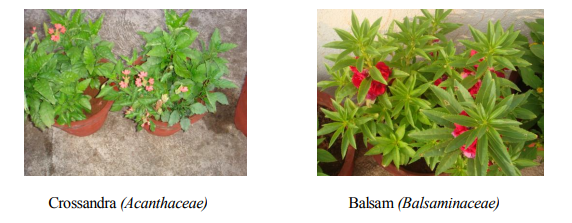
This is due to the more absorption of plant nutrients present in spentwash by plants at higher dilutions. It was also found that no negative impact of heavy metals like lead, cadmium and nickel on the leaves of Himalayan Balsam and Crossandra plant. The soil was tested after the harvest; found that there was no adverse effect on soil characteristics (Table-4)
References:
1. Wanted Himalayan Balsam, British isles.
2. A National History BBC, Retrieved 04 December 2009.
3. Impatiens glandulifera plants for a future.
4. Himalayan Balsam Retrieved o4 December 2009.
5. Yamunchi M.; Tsuruma K.; Imai S.; Nakanishi T.; Umigai N.; Shimajawa M.; Hara, H(2011).
6. European Journal of Pharmacology 650(1);110-9.
7. Joshi HC, Kalra N, Chaudhary A, Deb DL (1994). Environmental issues related with distillery effluent utilization in agriculture in India, Asia Pac J Environ. Develop, 1: 92-103.
8. Patil J.D, Arabatti SV, Hapse DG (1987). A review of some aspects of distillery spent wash (vinase) utilization in sugar cane, Bartiya sugar May, 9-15.
9. Ramadurai R, Gerard EJ (1994). Distillery effluent and downstream products, SISSTA, Sugar Journal. 20: 129-131.
10. Mohamed Haroon AR, Subash Chandra Bose M (2004). Use of distillery spentwash for alkali soil reclamation, treated distillery effluent for fertile irrigation of Crops. Indian Farm, March, 48- 51.
11. Pathak H, Joshi HC, Chaudhary A, Chaudhary R, Kalra N, Dwivedi MK (1998). Distillery effluent as soil amendment for wheat and rice. Journal of Indian Society for Soil Science. 46: 155-157.
12. Amar BS, Ashisk B, Sivakoti, R (2003). Effect of distillery effluent on plant and Soil enzymatic activities and ground nut quality. Journal of Plant Nutrition and Soil Science, 166: 345-347.
13. Ramana S, Biswas AK, Kundu S, Saha JK, Yadava RBR (2000). Physiological response of soybean (Glycine max L.) to foliar application of Distillery effluent. Plant Soil Research, 2: 1-6.
14. Kaushik K, Nisha R, Jagjeeta K. Kaushik CP (2005). Impact of long and short term irrigation of a sodic soil with distillery effluent in combination with Bio-amendments. Bioresource Technology, 96. (17): 1860-1866.
15. Kuntal MH, Ashis K, Biswas AK, Misra K (2004). Effect of post-methanation effluent on soil physical properties under a soybean-wheat system in a vertisol. Journal of Plant Nutrition and Soil Science. 167 (5): 584-590.
16. Raverkar KP, Ramana S, Singh AB, Biswas AK, Kundu S (2000). Impact of post methanated spent wash (PMS) on the nursery raising, biological Parameters of Glyricidia sepum and biological activity of soil. Ann. Plant Research, 2(2): 161- 168.
17. [17] Ramana S, Biswas AK, Kundu S, Saha JK, Yadava RBR (2001). Effect of distillery effluent on seed germination in some vegetable crops. Bio-resource Technology, 82(3): 273-275.
18. Devarajan L, Rajanna G, Ramanathan G, Oblisami G (1994). Performance of field crops under distillery effluent irrigations, Kisan world, 21: 48-50.
19. Singh Y, Raj Bahadur (1998). Effect of application of distillery effluent on Maize crop and soil properties. Indian J. Agri. Science., 68: 70-74.
20. Rani R, Sri Vastava MM (1990). Ecophysiological response of Pisum sativum and citrus maxima to distillery effluents. Int. J. of Ecology and Environ. Science, 16-23.
21. Rajendran K (1990).Effect of distillery effluent on the seed germination, seedling growth, chlorophyll content and mitosis in Helianthus Annuus. Indian Botanical Contactor, 7: 139-144.
22. Sahai R, Jabeen S, Saxena PK (1983). Effect of distillery waste on seed germination, seedling growth and pigment content of rice. Indian Journal of Ecology, 10: 7-10.
23. Chares S (1985). Vinasse in the fertilization of sugarcane. Sugarcane, 1, 20.
24. Samuel G (1986). The use of alcohol distillery waste as a fertilizer, Proceedings of International American Sugarcane Seminar.245-252.
25. Chandraju S, Basavaraju HC (2007). Impact of distillery spent wash on Seed germination and growth of leaves Vegetables: An investigation. Sugar Journal (SISSTA). 38: 20-50.
26. Chandraju S, Siddappa and Chidan Kumar C.S. (2011) Studies on the germination and growth of Musterd and Caster seeds irrigated by distillery spent wash, Bio-research bulletin 5:1-10.
27. Chandraju, S. Siddappa and Chidan Kumar C.S. (2011) Studies on the germination and growth of Cotton and Groundnut seeds irrigated by distillery spent wash, current Botony 2(3):38-42.
28. Manivasakam, N., (1987), Phisicochemical examination of water, sewage and Industrial effluent. Pragathi Prakashan, Merut.
29. Piper, C.S., (1966), Soil and Plant Analysis, Han’s Publication, Bombay.
30. Jackson, M.L., (1973), Soil Chemical Analysis. Prentice Hall of India Pvt. Ltd., New Delhi, p. 85.
31. Walkley, A.J. and Black, C.A., (1934), An examination of the method for determining soil organic matter and a proposed modification of the chromic acid titration method. Soil Sci., 37: 29- 38.
32. Subbiah, B.V. and Asija, G.L., (1956), A rapid procedure for the estimation of Available nitrogen in soils. Curr. Sci., 25: 259-260.
33. Black, C.A., (1965), Methods of Soil Analysis. Part 2, Agronomy monograph No. 9. Am. Soc. Agron., Madison, Wisconsin, USA, pp. 15-72
34. Lindsay, W.L. and Norvel, W.A., (1978), Development of DTPA soil test for Zn, Fe, Mn and Cu. Soil Sci. Soc. Am. J., 42: 421-428.
35. S.Chandraju, Thejovathi.C, Chidan Kumar.C.S., Sprouting and Growth studies of Rose and Hibiscus flowering plants irrigated by distillery spentwash. Research in Plant Biology, 1(2), 06-13. 2011.
36. S. Chandraju, Thejovathi.C, Chidan Kumar C.S., Studies on the Germination and Growth of Zinnia and Vinca seeds irrigated by Distillery spentwash. SISSTA, 2011.
37. S.Chandraju, Thejovathi.C, Chidan Kumar.C.S., Impact of Distillery spentwash irrigation on sprouting and Growth of Gardenia flowering plant. J. Chem. Pharm. Res. (In press)
38. S.Chandraju, Thejovathi C., Chidan Kumar C.S., Impact of Distillery spentwash irrigation on sprouting and Growth of Tagetes flowering plant Asian J. Research Chem, 2011 (Accepted).
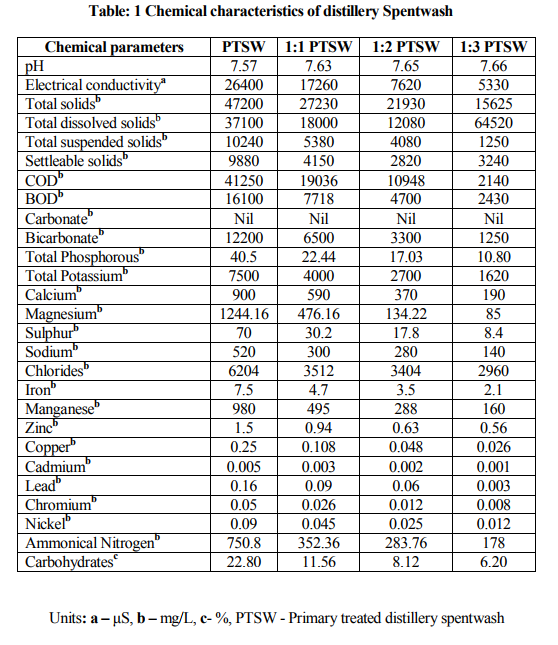
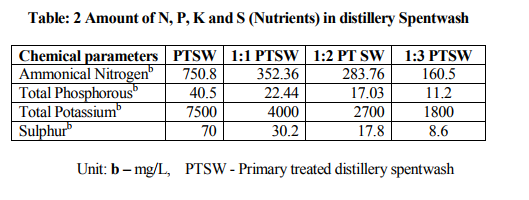
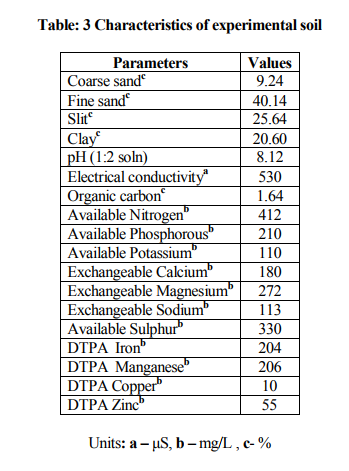
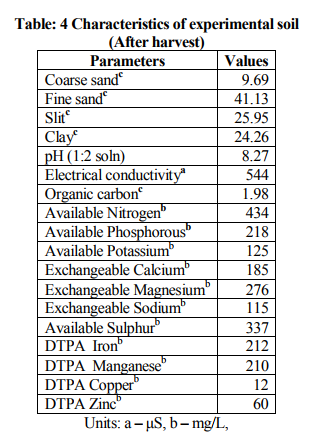

|






 This work is licensed under a Creative Commons Attribution-NonCommercial 4.0 International License
This work is licensed under a Creative Commons Attribution-NonCommercial 4.0 International License